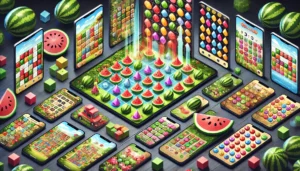The hyper-realistic graphics and gameplay mechanics are increasingly complex, but there exists a charming allure to the simplicity and nostalgia of retro gaming. Retro gaming refers to playing or collecting vintage video games, regularly those from the 1970s, 1980s, and 1990s. It’s a travel back in time, offering a glimpse into the evolution of the gaming industry and reminding us of the joy and energy we experienced in our youth.
The offer of retro gaming lies not only in the games themselves but moreover in the memories they inspire. For many enthusiasts, it’s a way to reconnect with their childhood or youth, remembering the moments spent huddled around a CRT tv with friends, furiously mashing buttons on a chunky controller. Each game holds an extraordinary place in our hearts, representing a time when life was easier and the only concern was reaching that next level or defeating that final boss.
One of the defining characteristics of retro gaming is its availability. Unlike modern gaming, which frequently requires expensive consoles or capable gaming PCs, retro games can be enjoyed on a variety of platforms, from classic consoles like the Nintendo Entertainment System (NES) or Sega Genesis to present-day emulators that allow players to experience these games on their computers or smartphones. This accessibility has made a difference fuel the resurgence of interest in retro gaming, making it easier than ever for both seasoned enthusiasts and newcomers to jump into gaming history.
Another viewpoint that sets retro gaming apart is its focus on gameplay over design. In a time where photorealistic visuals and cinematic experiences rule the gaming scene, retro games stand as a testament to the importance of immaculate, unadulterated fun. Whether it’s the timeless gameplay of classics like Super Mario Bros., the addictive challenge of arcade titles like Pac-Man, or the strategic profundity of role-playing games like Final Fantasy VI, retro games prioritize engaging mechanics and inventive design over flashy visuals. This emphasis on gameplay has contributed to the enduring offer of retro games, ensuring that they stay enjoyable decades after their initial release.
Retro gaming is also a treasure trove of social importance and historical context. Each game serves as a time capsule, reflecting the patterns, innovation, and well-known culture of its period. From the dynamic, pixelated artwork of 8-bit and 16-bit games to the famous soundtracks that have become ingrained in our collective memory, retro games offer a nostalgic trip down memory lane, transporting players back to a time when arcades were bustling hubs of social activity and home consoles were cutting-edge technology. Exploring the history of retro gaming allows us to appreciate how far the medium has come while also preserving the legacy of iconic titles and pioneering designers.
Moreover, retro gaming has cultivated a dynamic community of enthusiasts who share a passion for preserving gaming history and celebrating the classics. From retro gaming conventions and expos to online forums and social media groups, there are countless opportunities for fans to connect with like-minded people, swap stories, and find new favorites. This sense of camaraderie and shared nostalgia is at the heart of the retro gaming community, bringing together individuals of all ages and backgrounds united by their love of gaming.
Physicist William Higinbotham created the first video game in 1958, a very simple tennis game version, similar to the classic 1970s video game Pong.
The first online gaming platform is widely considered to be “The Gaming Club,” which was launched in 1994 by a company called Microgaming. It operated out of the Caribbean country of Antigua and Barbuda and offered a variety of classic games with basic graphic design. Certainly nowadays, games like Gates of Olympus are more captivating than the old versions of games, but those also had their charm. The Gaming Club paved the way for the online gaming industry, which has since developed exponentially, with thousands of online platforms presently available around the world.
The first gaming console is often considered to be the Magnavox Odyssey, which was released in 1972. Created by engineer Ralph H. Baer and his team at Sanders Associates, the Odyssey was a pioneering device that allowed users to play different games on their TV sets. It utilized interchangeable game cartridges and included extras such as plastic overlays for the TV screen to provide different backgrounds for the games. The Magnavox Odyssey featured basic games like table tennis, hockey, and others, which were depicted using basic graphics on the screen. Players would utilize physical controls and switches on the console itself to connect with the games.
In recent years, the popularity of retro gaming has only continued to develop, with a resurgence of intrigue in classic franchises and reimagined remakes. From the success of Nintendo’s NES and SNES Classic Edition consoles to the continuous accessibility of retro-inspired indie games, there’s no shortage of ways to experience the magic of retro gaming in the modern era. Whether you are a longtime fan looking to return to old favorites or a newcomer curious about gaming’s roots, retro gaming offers something for everyone, welcoming players on a nostalgic journey back in gaming history.









